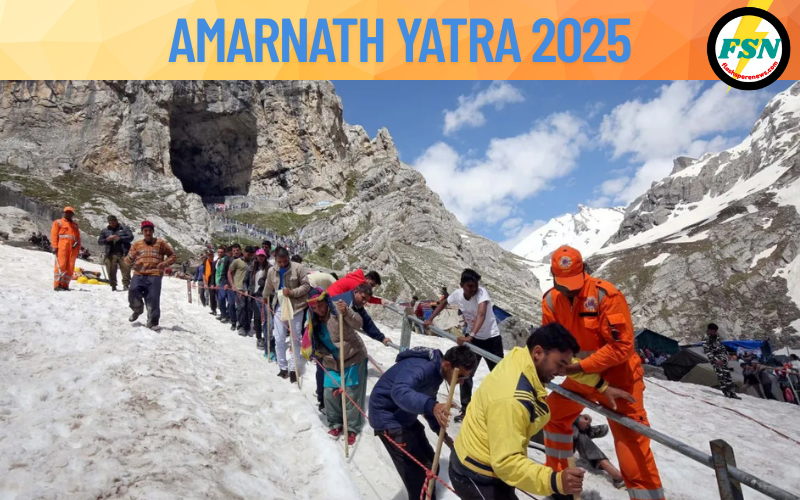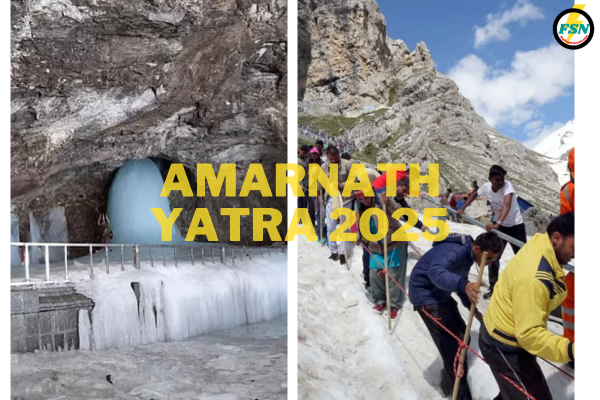
Divine Odyssey Begins: Amarnath Yatra 2025 Witnesses Massive Turnout Amid Tight Security
Srinagar, Jammu & Kashmir — The much-revered Amarnath Yatra 2025 officially commenced today with an overwhelming sense of devotion and discipline as thousands of devotees embarked on the sacred pilgrimage from the base camps at Nunwan in Pahalgam and Baltal in Ganderbal. With chants of “Bam Bam Bhole” echoing through the valleys and the Himalayan breeze carrying a wave of spirituality, the annual pilgrimage has once again brought the region alive with divine energy.
Historic Commencement of Amarnath Yatra 2025
Marking the beginning of one of India’s most significant spiritual events, Amarnath Yatra 2025 has seen an unprecedented influx of pilgrims on Day 1. Devotees from across the nation have flocked to Jammu & Kashmir to undertake the arduous journey to the holy Amarnath Cave, where the ice Lingam — believed to be a manifestation of Lord Shiva — naturally forms each year. The opening of the yatra was accompanied by elaborate ceremonies and pujas, symbolizing the divine commencement of this sacred undertaking.
The Lieutenant Governor of Jammu & Kashmir, Manoj Sinha, extended warm wishes to the pilgrims, expressing hope for a safe and spiritually enriching Amarnath Yatra 2025. He also emphasized the meticulous arrangements made by the administration and security forces to ensure that the pilgrimage proceeds without any disruptions.
Tight Security and Elaborate Infrastructure for Amarnath Yatra 2025
Considering past security concerns and the sensitive geographical terrain, the government has deployed thousands of security personnel, including CRPF, BSF, Army, and Jammu & Kashmir Police, across both the Baltal and Pahalgam routes. Advanced surveillance technology, including high-resolution drones and facial recognition systems, has been installed to monitor the movement along the pilgrimage routes.
To facilitate a smooth and secure Amarnath Yatra 2025, more than 100 medical camps have been set up along the route with round-the-clock healthcare professionals and paramedics. Oxygen booths, resting shelters, and refreshment centers have been strategically placed to support the yatris in the challenging Himalayan climate. This year, additional battery-operated vehicles and pony services have also been introduced to assist elderly and differently-abled pilgrims.
Voices from the Ground: Personal Stories from the Yatra
Rajesh Singh, a retired army veteran from Punjab, shared, “This is my fifth Amarnath Yatra, and every time I come, I feel reborn. The journey strengthens not just my body, but also my spirit.”
A group of young IT professionals from Bengaluru decided to undertake the yatra as a digital detox. “We’ve been glued to our screens for years. This journey gave us space to reflect, breathe fresh air, and reconnect with our cultural roots,” said Neha Ramesh, one of the group members.
Volunteers like 18-year-old Fahad from Anantnag are working long hours at medical booths. “Helping the yatris is a seva for us. It brings blessings and unity. We are proud to host the nation here,” he said.
Mid-Yatra Services and Natural Beauty Along the Route
The journey through the picturesque valleys of Kashmir adds a magical touch to the spiritual quest. As pilgrims ascend the altitudes, they traverse thick pine forests, cross icy streams, and behold breathtaking views of snow-clad peaks. At each halt — whether it’s Chandanwari, Sheshnag, or Panchtarni — the administration has arranged free langars (community kitchens) to ensure every pilgrim is fed.
Helicopter services for Amarnath Yatra 2025 are operating at full capacity this year, enabling even time-pressed or physically limited pilgrims to witness the darshan of the holy cave. With over 3 lakh registrations already confirmed, the cave shrine is expected to witness its highest footfall in recent years.
New Tech Innovations: Making the Yatra Smarter and Safer
The 2025 edition of the yatra has seen significant technological upgrades. RFID tags are being issued to each registered pilgrim to track movement and ensure safety. Mobile apps have been launched with real-time weather updates, route maps, and emergency contacts.
Digital registration and biometric ID scanning have reduced paperwork and crowding at base camps. The Shri Amarnathji Shrine Board (SASB) is also using AI-powered surveillance to detect unusual activity or medical distress signs in high-altitude zones.
New satellite phones and wireless communication systems have been provided to ground staff and security personnel, allowing seamless emergency coordination. These systems are particularly vital for areas with no mobile coverage during the Amarnath Yatra 2025.
NGO Contributions and Volunteer Support
Non-governmental organizations have played a pivotal role in supporting the logistics and hospitality during Amarnath Yatra 2025. From medical aid to free food distribution, volunteers are working tirelessly in high-altitude terrains. Groups like the Bharat Sevashram Sangha, Shiv Sena Seva Dal, and other local religious trusts have established their camps at key checkpoints.
Volunteers help pilgrims navigate steep climbs, carry luggage, and provide mental support for those facing altitude sickness or fatigue. Their dedication is a reflection of the selfless spirit that the yatra inspires among people of all backgrounds and regions.
The presence of volunteers trained in basic mountain rescue has significantly enhanced the safety net this year. Many of them are local youth from Kashmir who have grown up in the region and understand its terrains intimately.
Environmental Measures and Green Yatra Initiatives
In recent years, authorities have recognized the importance of preserving the pristine Himalayan ecosystem. Amarnath Yatra 2025 has introduced several green initiatives, including the use of biodegradable materials, solar-powered lighting, and eco-friendly waste management.
The Shri Amarnathji Shrine Board (SASB) has also launched an awareness campaign to educate pilgrims on minimizing plastic use and avoiding deforestation. Trash bins have been placed every 500 meters, and local volunteers are working with forest rangers to monitor compliance.
Eco-warriors like Priya Rawat, a 22-year-old environmental science graduate, have joined the mission. “Every wrapper thrown irresponsibly damages the fragile balance here. We are here to remind people that devotion must walk hand in hand with responsibility.”
Environmental audit teams have also been assigned this year to record carbon footprints and waste data during the Amarnath Yatra 2025. The initiative has been supported by various universities and government-backed sustainability cells.
Rituals at the Holy Cave: A Glimpse into Divine Practice
Upon reaching the Amarnath cave, pilgrims participate in sacred rituals, including the offering of holy water, flowers, and bel-patra leaves to the naturally formed ice Lingam. Pujaris (priests) conduct aarti ceremonies every morning and evening, creating an environment of profound spiritual vibration.
The cave, situated at an altitude of 3,888 meters, is revered for its ethereal silence and divine presence. Pilgrims are allowed limited time inside to avoid overcrowding, but most express an overwhelming sense of peace after darshan. For many, this moment is life-changing — a culmination of months, even years, of preparation and prayer.
The story of how Lord Shiva narrated the Amar Katha to Parvati in this cave adds a mythical layer to this deeply spiritual destination, making the Amarnath Yatra 2025 a holy event wrapped in legend.
Devotion Across Borders: Amarnath Yatra 2025 Attracts International Pilgrims
Notably, Amarnath Yatra 2025 has seen increased participation from Indian diaspora and spiritual tourists from countries like Nepal, Mauritius, Fiji, and even the United States. The Indian government’s outreach efforts and simplified visa processes have encouraged foreign participation in the yatra.
This international attention has further elevated the yatra’s global significance, showcasing India’s cultural and spiritual richness to the world. Temples abroad have even organized group yatras this year, with sponsorships from local religious communities.
Foreign pilgrims often describe the journey as life-changing. Thomas Brown, a spiritual seeker from the UK, shared, “The serenity of the Amarnath Cave, the devotion of the Indian people, and the energy on the path — it’s like walking through a living prayer.”
Socio-Economic Impact on Jammu & Kashmir
The economic impact of Amarnath Yatra 2025 on the local economy is immense. Hotels, restaurants, transport services, and local handicraft businesses flourish during the yatra season. According to estimates, the pilgrimage contributes over ₹1,200 crore to the UT’s economy annually.
Local residents often rent out homes, offer mule services, or work as porters and guides, providing employment opportunities in otherwise economically strained regions. Several women-led SHGs (self-help groups) are also earning through selling organic food items and woolen clothing to the yatris.
The ripple effect of this yatra’s success rejuvenates micro-economies in remote areas. Local artisans are using this occasion to showcase Pashmina shawls, saffron, and wooden crafts that reflect Kashmiri heritage. This cultural commerce has strengthened the bond between tourism and tradition.
Flashback to Challenges and Security Incidents
While this year’s arrangements are robust, it’s important to remember previous challenges. In 2017, a terrorist attack on a yatri bus shocked the nation. Since then, a multi-agency coordination protocol has been implemented to ensure no such threat disrupts the sanctity and safety of the yatra.
Road repairs, landslide mitigation techniques, and weather prediction systems have also been improved significantly. The Indian Meteorological Department is issuing hourly weather updates, while NDRF teams are stationed at vulnerable zones to handle emergencies.
In 2022, heavy rainfall had triggered flash floods near Baltal. Learning from such events, the administration now maintains live coordination with rescue teams, deploying early-warning systems and rapid response units.
The continued success of Amarnath Yatra 2025 rests on the lessons learned from these past trials, making this year’s journey not only better organized but spiritually safer.
The Symbolism and Historical Legacy of Amarnath Yatra
Legends say that Lord Shiva revealed the secret of immortality to Goddess Parvati in the Amarnath Cave. To ensure that no living being overheard the sacred conversation, he left behind all his companions — including Nandi, the moon, the snake, and even the five elements.
This tale, passed down through generations, gives deep symbolic meaning to the pilgrimage. For centuries, saints, rishis, and kings have undertaken this journey to purify their soul and seek divine wisdom. The yatra isn’t just a trip to a shrine — it’s a metaphysical voyage inward.
The first recorded pilgrimage dates back to 11th century CE, mentioned in Rajatarangini, the historical chronicle of Kashmir. Over time, this annual journey has withstood political upheavals, natural calamities, and military tensions — emerging stronger each year.
The Amarnath Yatra 2025 thus represents continuity, resilience, and renewal — virtues deeply rooted in Indian philosophy.
Post-Yatra Impact: Reflections from Returning Pilgrims
Many pilgrims report experiencing a post-yatra transformation. “I came here searching for peace and purpose. I am going back lighter — not physically, but emotionally,” said Karan Malhotra, a first-time yatri from Delhi.
Psychologists studying pilgrimage behavior note that journeys like the Amarnath Yatra 2025 can have lasting emotional and spiritual benefits. The physical effort, coupled with religious immersion, fosters mindfulness, humility, and gratitude.
Spiritual leaders suggest maintaining the discipline learned during the yatra. Daily prayers, simple food, and reduced digital dependency are some habits that yatris try to continue after returning to their urban routines.
Yoga sessions and community satsangs held post-yatra in many cities aim to carry the spiritual energy forward. This has led to the creation of what many now call the Amarnath Yatra community — a growing fellowship of devotees sharing experiences and wisdom.
Final Thoughts: Faith Beyond Barriers
As Amarnath Yatra 2025 continues in full fervor, it is evident that this journey transcends caste, region, language, and wealth. In those mountainous trails, all identities dissolve — only devotion remains. The icy cave stands not just as a geological marvel, but as a beacon of hope, resilience, and faith.
In a world increasingly divided by digital chaos and urban disconnection, the yatra reminds us of something eternal — the path to the divine is open for all, but only faith can guide the way.
Every pilgrim’s story becomes part of a collective legacy, etched into the Himalayas. Whether one reaches the cave on foot, by pony, or by helicopter, the spiritual ascent is the same. And as the chant of “Har Har Mahadev” echoes through the valleys, it carries with it the soul of a united India, rooted in devotion and uplifted by grace.

